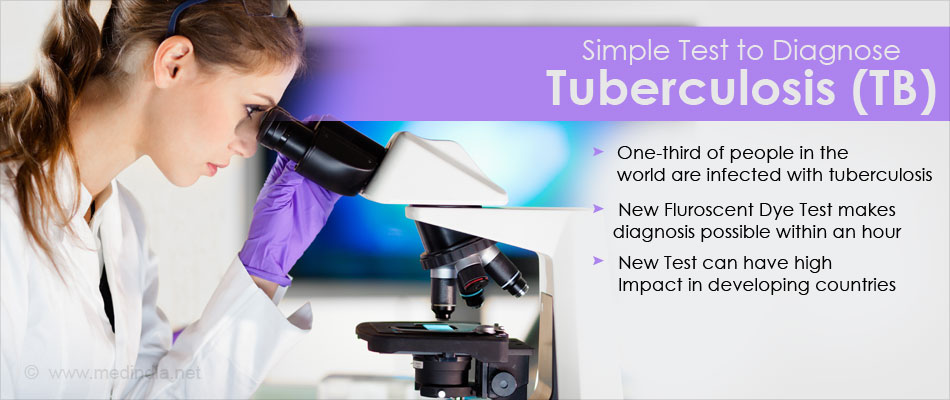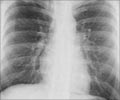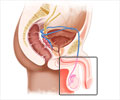
- Tuberculosis (TB) a serious infectious bacterial disease affects the lungs
- TB diagnosis takes a few days which is time consuming
- New fast test developed by scientists requires a very short time for the results to be inferred
The New and Simple Test for Early Diagnosis of Tuberculosis
The new Tuberculosis test involves mixing the sputum sample with the Fluorescent Dye like Solvatochromic and then leaving it aside for one hour. After which the sample is viewed under the microscope for the presence of any glow. Advantages of the New Method- This is a simple test that is easy to carry out and requires a very short time for the results to be inferred.
- It does not require expensive equipment or electricity, which are not always available in certain parts of developing countries.
- Only live bacteria are detected using this method. This is a big advantage over the Ziehl Neelsen test that detects both live and dead bacteria. The ZN test, therefore, cannot be used to detect the effectiveness of treatment procedures. As Dr. Bertozzi adds “if the drugs aren’t working, you want to switch the patient to the next treatment as quickly as possible so you don’t contribute to drug resistance.”
Some other researchers, who were studying the bacterium and its ability to pick up the trehalose sugar and integrate into its glycoprotein, tagged the sugar molecule with fluorescent dye. Though this technique promised to aid in better detection of the bacterium in the saliva, it had its drawbacks. The florescent dye got attached to certain components of saliva, making detection of the bacterium difficult.
Solvatochromic Dye
Bertozzi and colleagues attached the trehalose to solvatochromic dye that began to glow only when the sugar molecule was integrated into the glycoprotein of the bacterium.
About Tuberculosis
During the primary infection of this bacterium, the immune system of the host attacks the bacteria and prevents them from growing. This is called latent TB, where there are no symptoms and the person cannot spread the infection. However, the bacteria continue to live inside the host body in the form of a spore.When the immune system of the host is compromised due to another infection or disease, the TB bacterium begins to grow and will give rise to a full-fledged TB infection.
- Persistent coughing
- Chest pain
- Weight loss
- Loss of appetite
- Fever
- Night sweats
- Blood with sputum
People who look after patients with tuberculosis are at risk of getting the disease themselves. Young children and elderly are also at risk of being infected. Other people who are at high risk of getting the disease include people who work in prisons, shelters for the homeless and health workers who are in close contact with people who may suffer from the disease.
- It has been estimated that nearly one-third of people in the world are infected with tuberculosis.
- According to 2014 statistics, there were 9.4 million people in the world who were infected with tuberculosis.
- TB is highly infectious when the individual is attacked by another disease that lowers the immune system.
- TB is the leading cause of death among individuals who are infected with HIV.
- Internationally when people who have both HIV and TB die, they are categorized as having died due to HIV infection.
- In 2014, there were one million cases of TB amongst children.
Current Problems in Diagnosis
- The major hindrance to eliminating TB is the long drawn process of diagnosis. Currently TB diagnosis takes a few days which is time consuming and requires additional resources.
- In developing countries, where TB is common, people need to travel to cities from villages to avail treatment. When the diagnosis takes a few days for the results to come in, people refuse to stay in the cities to receive the results. They are forced to go back to their village even before the results are ready as they need to spend on living expenses for a couple of additional days spent in the city. This leads to a continued spread of the disease.
- Hospitals are short staffed and cannot afford to send a message to the village regarding their disease status. This leads to an inability to begin treatment.
- In developed countries, doctors rely on chest x-rays for better diagnosis. The sputum of the patients is then sent for polymerase chain reaction (PCR) and analysis. These methods give an accurate result within a short period of time. However, in developing countries, the use of X-rays and PCR are limited by lack of access to continuous electricity and poor affordability.
Ziehl Neelsen (ZN) Test
The Ziehl Neelsen test involves fixing the saliva sample on a glass slide and then staining it several times to detect the presence of the organism. The entire process is time consuming and it fails to detect Mycobacterium sometimes or gives rise to false positive test.The lead researcher of the study Dr. Carolyn R. Bertozzi who set out to find a better diagnostic test for TB says “The ZN test is not very sensitive. It misses some cases of TB, and it gives a lot of false positives.”
The researchers of the study have been studying the bacterium for 16 years.
Structure of the Bacterium
The scientists studied the glycolipids that were present in the walls of the bacterium. They found that each glycolipid consisted of a sugar trehalose that was attached to either a fat or a lipid.
When carefully modified trehalose were provided to the bacterium, the sugar molecules were metabolized and were integrated into glycoprotein.
References:
- Tuberculosis (TB) Disease: Symptoms & Risk Factors - (http://www.cdc.gov/features/tbsymptoms/)
- Tuberculosis - (https://medlineplus.gov/tuberculosis.html)
- Data and Statistics - (http://www.cdc.gov/tb/statistics/)
- TB Statistics – Global, regional & high burden - (http://www.tbfacts.org/tb-statistics/)













